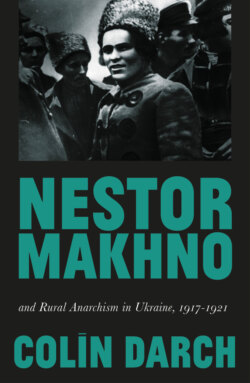Читать книгу Nestor Makhno and Rural Anarchism in Ukraine, 1917-1921 - Colin Darch - Страница 8
На сайте Литреса книга снята с продажи.
Acknowledgements
ОглавлениеMy interest in makhnovshchina dates back to the late 1960s, and the research for this book was carried out intermittently over the many years since then by visits to, or through correspondence with the following libraries, archives and research centres. I owe an enormous debt of gratitude to the librarians and archivists who have assisted me both personally and by providing me with photocopies or microfilm of necessary documents: the Bibliothèque de Documentation Internationale Contemporaine (BDIC), Nanterre; the Bibliothèque Nationale, Paris; the British Library, London; the Bundesarchiv, Koblenz; the Canadian Mennonite Bible College Library, Winnipeg; the Centre Internationale des Recherches sur l’Anarchisme, Lausanne; Columbia University Library, New York City; the Deutsche Bücherei, Leipzig; what was then the Gosudarstvennaia Biblioteka SSSR im. V. I. Lenina, Moscow; the then Gosudarstvennaia Publichnaia Biblioteka im. M. E. Saltykova-Shchedrina, St. Petersburg; the Hoover Institution on War, Revolution and Peace, Stanford University; Indiana University Library, Bloomington; the Internationaal Instituut voor Sociale Geschiedenis, Amsterdam; the Library of Congress, Washington DC; the National Library of Canada, Ottawa; New York Public Library, New York City; the School of Slavonic and East European Studies, University of London; the Schweizerische Landesbibliothek, Berne; the Bodleian Library, Oxford; the University Libraries of the University of Birmingham, the University of Bradford, the University of Helsinki, the University of Michigan in Ann Arbor, the University of Toronto and the University of Wisconsin; and the YIVO Institute for Jewish Research, New York City.
I want to acknowledge and thank the people who, over a long period of many years have given generous, willing and unstinting assistance in the research, writing, correspondence and, of course, conversation that have led to this book. It’s possible that some may have forgotten assisting me. Their help included granting me access to unpublished memoirs and other documents, responding to factual and other queries, criticising draft chapters and helping with translation. I must mention especially Ivan Antypenko of Philadelphia; Paul Avrich; Delice Baker-Duly who provided Swedish translations many years ago; G. N. Britten; the late E. H. Carr; the late Richard Caulk; Georgi Derluguian; Irina Filatova for several points of clarification; M. Fransiszyn; Daniel Guérin; Zenon Jaworskyi; Viktor Kachun; Annemarie Kinfu who provided German translations; Michel Kovetzki; the late A. L. Morton; Richard and Rita Pankhurst; Sean Patterson; Victor Peters; Michael Petrowsky; Mark Plant; the Very Rev. N. Pliczkowski; Jenny Sandler, who drew the maps; Alexandre Skirda; the late Teodor Shanin; Iuri Shevchenko of the University of Khar’kov for assistance with routes and distances; Vladimir Shubin (no relation of Aleksandr Shubin) for critical comments; Yehuda Slutsky for sharing his work on the Ukrainian pogroms; the late Volker Stitz; Lucien van der Walt; Leo van Rossum; Gottfried Wellmer who provided German translations; Dr. Olex Wintoniak of Dniprova Khvylia; the late Michael Wolfers; and Jason Yanowitz. Last, my special and enduring thanks go to Gary Littlejohn, who supervised with good humour and patience my now-superseded doctoral dissertation on makhnovshchina, and has also read through this manuscript and made many valuable suggestions; to Leo Zeilig, without whose enthusiastic encouragement a version of this work would still be lying in the bottom of a drawer; and to first Hilary Davies, Tom Rampling and Toni Ongala, and later Agnes Nkhoma-Darch for their many years of extraordinarily patient support. My thanks to the four anonymous reviewers of my original proposal, and to Pluto Press for their ongoing support – specifically to David Shulman, for his patience, and to Robert Webb. Some of the people mentioned above will almost certainly find themselves for various reasons in more or less strong disagreement with my argument and my conclusions, which now differ significantly from my earlier views on the Makhno rebellion. Nonetheless, I am grateful for their help.
Needless to say, I alone am entirely responsible for the interpretation as well as for all errors and omissions of whatever kind in this book.
Map 0.1Makhnovshchina’s Areas of Activity and Influence, 1918–21
The heartland of makhnovshchina was based around Guliaipole, Ekaterinoslav and Aleksandrovsk, but the movement’s influence extended intermittently over a much wider area. (Cartographer: Jenny Sandler).
